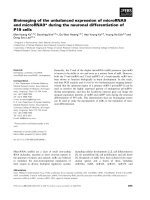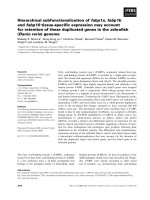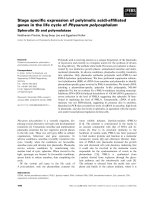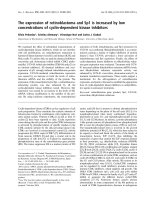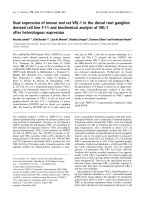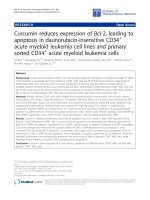Distinct histone deacetylases repress expression of LH and FSH beta genes in the immature gonadotrope alphat3 1 cells and the repression is reversed by GNRH
Bạn đang xem bản rút gọn của tài liệu. Xem và tải ngay bản đầy đủ của tài liệu tại đây (1.72 MB, 94 trang )
DISTINCT HISTONE DEACETYLASES REPRESS
EXPRESSION OF LH AND FSH β GENES IN THE
IMMATURE GONADOTROPE αT3-1 CELLS AND THE
REPRESSION IS REVERSED BY GNRH
YANG MENG
THE NATIONAL UNIVERSITY OF SINGAPORE
2007
DISTINCT HISTONE DEACETYLASES REPRESS
EXPRESSION OF LH AND FSH β GENES IN THE
IMMATURE GONADOTROPE αT3-1 CELLS AND THE
REPRESSION IS REVERSED BY GNRH
YANG MENG
A THESIS SUBMITTED
FOR THE DEGREE OF MASTERS OF SCIENCE
DEPARTMENT OF BIOLOGICAL SCIENCES
THE NATIONAL UNIVERSITY OF SINGAPORE
2007
ACKNOWLEDGEMENTS
This is perhaps the easiest and hardest chapter that I have to write. It will be simple to
name all the people that helped to get this done, but it will be tough to thank them
enough. I will nonetheless try…
First of all, I must send thanks to all the HDAC team members. Without their support
and striving development the project would have never reached the great result it did.
Dr Philippa Melamed, my supervisor, she always encourages me to bring forth my own
ideas and to test them independently. Those warm discussions, just as warm as the
weather in Singapore, are unforgettable. I am very happy that at the early stage of my
research life, I could establish my faith on science and learn to figure out the problems,
which is common in bio-research, with great enthusiasm.
My wonderful lab mates, Luo Min, Stefan, Jia Jun, Siew Hoon, Fai, who’ve made our lab
a lively and enjoyable place to work in. And those previous colleagues, their preliminary
tests and hypothesis are the source of my inspiration. Dr Martin Lee, his suggestions
really saved me for some of the protein tests.
My lovely friends, church or campus which are too many to mention, always stood by
my side asking over and over again “When will you get it done? Next week? Next Month?
When?”
My final words go to my family. In this type of work the relatives are always mistreated
A great thanks to all.
I
ABSTRACT
The gonadotropins, luteinizing hormone (LH) and follicle-stimulating hormone (FSH)
are synthesized in and secreted by the pituitary gland, and play crucial roles in regulating
reproduction. The synthesis of both LH and FSH is repressed soon after birth until
puberty, when the repression is reversed by gonadotropin-releasing hormone (GnRH).
Chromatin immunoprecipitation (ChIP) assays have shown that in the immature pituitary
gonadotrope αT3-1 cells, distinct sets of histone deacetylases (HDACs), along with
SMRT and Sin3A, associate with LH and/or FSH β-subunit gene promoters in a
repressive complex. In order to understand the de-repression of LH and FSH β genes in
αT3-1 cells, the effect of GnRH treatment on this repressive complex must be elucidated.
ChIP assays have shown that GnRH is able to remove several HDACs and Sin3A from
LH and/or FSH β gene promoters, which results in the disruption of the repressive
complex. De-repression of the LH and FSH β genes after GnRH stimulation might be
caused by class IIa HDAC modifications which lead to the nuclear export of those
HDACs. SENP1, a nuclear protease that appears to deconjugate sumoylated proteins,
reverses the repression of both the LH and FSH β genes in the αT3-1 cells. It is possible
that GnRH stimulation recruits the de-sumoylation pathway to export the class IIa
HDACs from the nucleus resulting in the disruption of the repressive complex.
II
TABLE OF CONTENTS
LIST OF FIGURES ...................................................................................... 1
LIST OF TABLES ........................................................................................ 3
LIST OF ABBREVIATIONS ...................................................................... 4
CHAPTER 1 INTRODUCTION ............................................................... 6
1.1The gonadotropins: lutenizing hormone (LH) and follicle-stimulating
hormone (FSH).............................................................................................. 6
1.2. Gonadotropin-releasing hormone (GnRH) regulates LH and FSH βsubunit synthesis ......................................................................................... 10
1.2.1 Basal expression of LH and FSH β-subunit genes ..............................................10
1.2.2 GnRH-mediated expression of LH and FSH β-subunit genes ...........................12
1.3. Regulation of LH and FSH β genes through their transcriptional
repression..................................................................................................... 15
1.3.1 Histone deacetylases (HDACs) repress gene expression ....................................15
1.3.2 Transcription regulators: class IIa HDACs, N-CoR/SMRT and mSin3A........20
1.3.3 Modification of Class IIa HDACs by phosphorylation or SUMOylation affects
their repressive functions. ..............................................................................................24
1.4. Mouse gonadotrope cell lines: αT3-1 and LβT2 ............................... 28
1.5. Hypothesis and aims ............................................................................ 30
III
CHAPTER 2
MATERIALS AND METHODS ................................... 31
2.1. Tissue culture ....................................................................................... 31
2.1.1. Growth condition ..................................................................................................31
2.1.2. Transient transfection ..........................................................................................31
2.2. Preparation of plasmid DNA .............................................................. 32
2.2.1 Expression vectors .................................................................................................32
2.2.2 siRNA constructs to target N-CoR, SMRT and Sin3A.......................................32
2.2.2.1 Design of oligonucleotides ......................................................................................................... 32
2.2.2.2 Annealing of oligonucleotides ................................................................................................... 33
2.2.2.3. Restriction digestion of vectors................................................................................................ 34
2.2.2.4. DNA purification ...................................................................................................................... 34
2.2.2.5. Ligation of annealed oligos and linearized pSUPER vector.................................................. 34
2.2.3 Isolation, verification and large scale preparation .............................................35
2.2.3.1. Transformation of plasmids into Escherichia coli (E.coli) .................................................... 35
2.2.3.2. Plasmid isolation and verification ........................................................................................... 36
2.3. RT-PCR analysis.................................................................................. 37
2.3.1. RNA isolation ........................................................................................................37
2.3.2. First strand cDNA synthesis ................................................................................38
2.3.3. PCR and gel electrophoresis analysis..................................................................38
2.4. Western blotting................................................................................... 40
2.4.1. Whole cell extraction ............................................................................................40
2.4.2. Nuclear and cytoplasmic extraction ....................................................................40
2.4.3. SDS page and blotting ..........................................................................................40
2.5. Co-immunorecipitation (Co-IP) ......................................................... 43
2.6. Chromatin Immunoprecipitation (CHIP)......................................... 44
IV
2.6.1. Cross-linking of protein and DNA.......................................................................44
2.6.2. Immunoprecipitation of protein-DNA complex and DNA extraction .............45
2.6.3. PCR detection........................................................................................................46
CHAPTER 3 RESULTS........................................................................... 48
3.1. Gonadotropin β-subunit genes are repressed by HDACs in the
immature gonadotrope αT3-1 cell line and GnRH is able to overcome
this repression ............................................................................................. 48
3.2. Co-repressors are identified that repress the FSH β gene in both
αT3-1 and LβT2 cells.................................................................................. 50
3.3. Distinct sets of HDACs and co-repressors are associated with the
LH and FSH β gene promoters, and the association is affected by GnRH
treatment...................................................................................................... 53
3.4. Co-immunoprecipitation indicates that the repressive factors
associated with the LH and FSH β-subunit gene, are contained in more
than one complex at each gene promoter ................................................. 60
3.5. GnRH-mediated modification of HDAC4 and HDAC5 facilitates
their nuclear export .................................................................................... 63
CHAPTER 4 DISCUSSION .................................................................... 67
V
LIST OF FIGURES
Figure Titles
Page
Figure 1. Functional connection between the hypothalamus and pituitary gland.
7
Figure 2. Regulation of gonadotropin gene expression.
8
Figure 3. A model of basal gonadotropin subunit gene expression.
11
Figure 4. The gonadotropin-releasing hormone (GnRH) receptor-modulated signaling
network.
13
Figure 5. Histone acetylation-deacetylation cycle.
16
Figure 6. Schematic depiction of the different isoforms of various HDACs.
18
Figure 7. Repressive complexes are associated with the promoter to repress gene
expression.
19
Figure 8. Translocation of HDAC7 causes de-repression of Nur77 gene in developing
thymic T cells.
21
Figure 9. Domains of the N-CoR and SMRT co-repressors.
23
Figure 10. Model for SUMOylation function in regulating transcription.
27
Figure 11. The gonadotrope cell lines along the developmental cell lineages of the
anterior pituitary.
29
Figure 12. LH and FSH β-subunit gene expression is repressed in immature αT3-1
cells and this is overcome by GnRH.
49
Figure 13. SMRT represses expression of the FSHβ gene in both cell types.
50
Figure 14. In αT3-1 cells, both transcript and protein levels of N-CoR and SMRT are
decreased following the respective siRNA-mediated knock down.
52
Figure 15. In αT3-1 cells, several HDACs are associated with the LH β promoter and
the association is differentially affected by GnRH treatment.
54
Figure 16. In αT3-1 cells, several HDACs are associated with the FSH β promoter
and this is differentially affected by GnRH treatment.
55
Figure 17. In αT3-1 cells, neither N-CoR nor SMRT is associated with the LH β
promoter but SMRT is recruited following GnRH treatment.
57
Figure 18. In αT3-1 cells, SMRT is associated with the FSH β promoter and this is
not affected by GnRH treatment.
58
Figure 19. In LβT2 cells, several HDACs along with co-repressors are associated with
the FSH β promoter and the association is differentially affected by GnRH treatment.
59
1
Figure 20. In αT3-1 cells, class I HDACs co-precipitate with class IIa HDACs and corepressors.
61
Figure 21. In αT3-1 cells, HDAC4 co-precipitated with the co-repressor Sin3A but
not with either SMRT or HDAC5.
62
Figure 22. In αT3-1 cells, the repression of LH and FSH β-subunit genes is overcome
by over-expression of SENP1.
64
Figure 23. In αT3-1 cells, HDAC5 is present in two forms in both cytoplasmic and
nuclear extraction, one appears 20 kD bigger, and this is not affected by NEM
treatment.
64
Figure 24. In αT3-1 cells, localization of wild-type HDAC5 in both nucleus and
cytoplasm is SUMO-dependant, and this is affected by GnRH treatment.
66
Figure 25. SUMOylation and nuclear import.
74
Figure 26. Repressive complexes containing distinct HDACs repress expression of
the gonadotropin β-subunit genes in αT3-1 cells, and this is overcome by GnRH
treatment.
78
2
LIST OF TABLES
Table Titles
Page
Table 1. Optimized amount of plasmids transfected into the cell lines
32
Table 2. Oligonucleotides designed for synthesis of siRNA
33
Table 3. Conditions for annealing of oligonucleotides
33
Table 4. Components of reaction for T4 ligatio
34
Table 5. Mix preparation for the restriction digestion
36
Table 6. Mix for the sequencing reaction
37
Table 7. Cycling parameters for sequencing reaction
37
Table 8. Mix for the first strand cDNA synthesis
38
Table 9. Mix of PCR to test expression level of the LHβ, FSHβ and β-actin
39
Table 10. PCR cycling parameters to analyze LHβ, FSHβ and β-actin gene expression
39
Table 11. Primers used to amplify LHβ, FSHβ and β-actin
39
Table 12. Composition of buffers used in western blot
42
Table 13. Antibodies used in western blotting; Regarding anti-SMRT, one is
particularly used for western blotting following co-precipitation
42
Table 14. Antibodies used in immuno-precipitation
43
Table 15. Composition of buffers used in ChIP experiments.
46
Table 16. Antibodies used in ChIP
47
Table 17. PCR cycling parameters to amply specific regions of the FSHβ and LHβ
gene promoters.
47
Table 18. Primers used to amply LH and FSH β promoter region .
47
3
LIST OF ABBREVIATIONS
CaM
Ca2+ sensor calmodulin
CaMKs
Ca2+/CaM-dependent protein kinases
ChIP
Chromatin immunoprecipitation
DAD
Deacetylase activating domain
DAG
Diacylglycerol
EGF
Epidermal growth factor
ERK
Extracellular-signal-regulated kinase
FSH
Follicle-stimulating hormone
FSHβ
Follicle-stimulating hormone β-subunit
GnRH
Gonadotropin-releasing hormone
GnRHR
Gonadotropin-releasing hormone receptor
HAT
Histone acetyltransferase
Hda1
Histone deacetylase 1
HDAC
Histone deacetylase
HDACi
Histone deacetylase inhibitors
IP3
Inositol 1,4,5 triphosphate
JNK
Jun N-terminal kinase
LH
Luteinizing hormone
LHR
Luteinizing hormone receptor
LHβ
Luteinizing hormone β-subunit
MAPK
Mitogen-activated protein kinase
MEK
Mitogen-activated protein kinase kinase
N-CoR
Nuclear receptor corepressor
NES
Nuclear export signal
NLS
Nuclear localization signal
NPC
Nuclear pore complex
NURD
Nucleosome remodeling and histone deacetylation
PIP
Plasmid immunoprecipitation
4
Pitx1
Pituitary homeobox 1
PKA
Protein kinase A
PKC
Protein kinase C
PLC
Phospholipase C
SENP
Sentrin/SUMO-specific protease
Sf-1
Steroidogenic factor 1
Sir2
Silent information regulator 2
siRNA
Short interfering ribonucleic acids
SMRT
Silencing mediator of retinoic and thyroid hormone receptors
SUMO
Small ubiquitin-related modifier
TSA
Trichostatin A
Ubc
Ubiquitin conjugating
5
CHAPTER 1
1.1
INTRODUCTION
The gonadotropins: lutenizing hormone (LH) and follicle-stimulating
hormone (FSH)
The pituitary gland is a small gland located at the base of the brain, functionally linked to
the hypothalamus. It is divided into two lobes: the anterior or front lobe and the posterior
or rear lobe (Figure 1). The anterior pituitary is composed of a number of different cell
types, including five endocrine cells (Jacobson et al. 1979). One of these are gonadotrope
cells which secrets two gonadotropins: luteinizing hormone (LH) and follicle-stimulating
hormone (FSH). The synthesis and secretion of gonadotropins are subject to the complex
control of many factors (Figure 2) including GnRH (Papavasiliou et al. 1986; Kato et al.
1989; Ruf and Sealfon 2004), steroid hormones (testosterone, estrogen and progesterone)
and gonadal peptides (activin, inhibin and follistatin) (Gharib et al. 1990; Joshi et al.
1993).
6
Anterior pituitary
Posterior pituitary
Figure 1. Functional connection between the hypothalamus and pituitary gland.
The anterior pituitary gland is functioning connected with the hypothalamus; nerve
cells in the hypothalamus secrete neurohormones that act on the endocrine cells of the
anterior lobe to stimulate or inhibit their synthesis and secretion. Abbreviations: AL,
anterior lobe; PL, posterior lobe; MB, mammillary body (Nussey and Whitehead
1999).
7
Hypothalamus
GnRH
Pituitary
FSH
and
LH
Gonadal Peptides
Inhibin (-ve), Activin (+ve), Follistatin (-ve)
Gonads
Steroids
Testosterone, Estrogen, Progesterone
Figure 2. Regulation of gonadotropin gene expression. GnRH, synthesized in and
released from the hypothalamus, binds to GnRH receptors on the surface of the
gonadotrope. This leads to the synthesis and secretion of LH and FSH, which
stimulate the production of steroid hormones. Testosterone, estrogen and
progesterone negatively or positively regulate the synthesis of the gonadotropins
directly at the pituitary or indirectly by modulating GnRH secretion from the
hypothalamus. The gonadal peptides, inhibin, activin and follistatin, also have roles
in the regulation of gonadotropin gene expression by exerting positive or negative
feedback (Brown and Mcneilly 1999).
8
Both LH and FSH are glycoproteins and are composed of one α-subunit which is
identical, and one β-subunit which is unique and endows each hormone with the ability
to bind to its own receptor. These hormones stimulate the activation of the gonads: in
females, the ovaries; and in males, the testes. FSH in females initiates follicular growth,
specifically through the actions on granulosa cells, whereas in males, FSH stimulates the
maturation of germ cells. The name LH is derived from its effect of inducing
luteinization of ovarian follicles. LH receptors are expressed on the maturing follicle that
produces an increasing amount of estradiol with the rise in estrogens. With maturation of
the follicle, the estrogen rise leads a surge in LH levels over a 24-48 hour period. This
LH surge triggers ovulation and initiates the conversion of the residual follicle into a
corpus luteum that, in turn, produces progesterone to prepare the endometrium for a
possible implantation. Progesterone is necessary for maintenance of pregnancy, and in
humans, LH is required for continued development and function of corpora lutea. In
males, LH acts upon the Leydig cell of the testis and stimulates testosterone production
that promotes spermatogenesis and is responsible for the male secondary sexual
characteristics.
9
1.2
Gonadotropin-releasing hormone (GnRH) regulates LH and FSH β-subunit
synthesis
1.2.1 Basal expression of LH and FSH β-subunit genes
During embryogenesis, a controlled cascade involving multiple signaling pathways
determines the transcription factor expression which initiates the basal expression of
gonadotropin genes (Treier et al. 1998). The initiation of the gonadotrope cell lineage is
characterized by expression of the α-subunit followed by the expression of LH and FSH
β subunit transcripts after a further 5 - 6 days. Transcription factors such as pituitary
homeobox 1 (Ptx1) and steroidogenic factor 1 (SF-1) have been reported to activate
gonadotropin α and β subunit gene transcription at the basal level (Figure 3). Although
both LH and FSH are produced during fetal development, their synthesis is repressed
after birth until re-activation at puberty, when the GnRH pulse generator is activated,
resulting in increased GnRH release (Grumbach 2003). As such, the appropriate GnRH
delivery to the gonadotrope is the only endogenous block to the reawakening of the
GnRH-gonadoptropin axis at puberty which has been shown by the experiment that
precocious puberty leading to ovulation can be stimulated in monkeys merely by the
appropriate administration of GnRH (Wildt et al. 1980; Plant et al. 1989).
10
Figure 3. A model of basal gonadotropin subunit gene expression. Transcription
factors involved in basal gonadotropin subunit gene expression are activated during
anterior pituitary development and are shown bound to their cognate DNA elements
at the gonadotropin subunit gene promoters (Brown and Mcneilly 1999).
11
1.2.2 GnRH-mediated expression of LH and FSH β-subunit genes
The decapeptide GnRH (pGlu-His-Trp-Ser-Tyr-Gly-Leu-Arg-Pro-Gly-NH2), released in
a pulsatile pattern by GnRH-producing neurons of the hypothalamus, is the chief
regulator of the reproductive system in mammals. The GnRH receptor, a heptahelical
membrane protein on the surface of the anterior pituitary gonadotrope is activated
following GnRH binding, resulting in a signal transduction network. After receptor
activation, the signal transduction network of the gonadotrope reliably decodes the
instructions received to generate the appropriate rates of gonadotropin bio-systhesis and
secretion (Figure 4).
When GnRH interacts with its receptor, it stabilizes a conformational change in the
receptor that promotes the activation of heterotrimeric G proteins. The principle G
protein activated by GnRH belongs to the Gq/11 subclass, while G proteins of the Gi/o
and Gs subclasses have also been reported to be activated by GnRH (Ruf et al. 2003). In
αT3-1 cells, the endogenous mouse receptor was found to be consistent with activation
solely of Gq/11 subtype G-proteins, while, in the related LβT2 gonadotrope cell line, the
endogenous mouse receptor was found to activate both Gq/11 and Gs sub-type Gproteins (Grosse et al. 2000; Liu et al. 2002b).
12
Figure 4. The gonadotropin-releasing hormone (GnRH) receptor-modulated signaling network. Activation of the
GnRH receptor leads to the activation of at least two G-protein subtypes, Gs and Gq. Signaling downstream of protein
kinase C (PKC) leads to transactivation of the epidermal growth factor (EGF) receptor and activation of mitogen-activated
protein kinases (MAPKs), including extracellular-signal-regulated kinase (ERK), Jun N-terminal kinase (JNK) and p38
MAPK. Active MAPKs translocate to the nucleus, resulting in activation of transcription factors and rapid induction of
early genes. This figure illustrates the distributed and interconnected movement of information from the receptor to the
genome (Ruf and Sealfon 2004).
13
Phospholipase Cβ is activated by Gq/11 proteins (Hsieh and Martin 1992), leading to the
hydrolysis of phosphatidylinositol 4, 5-bisphosphate to 1,4,5 - inositol trisphosphate (IP3)
and diacylglycerol (DAG). IP3 mobilizes intracellular calcium which activates
conventional protein kinase C (PKC) isoforms such as β and βII, which have been
identified in gonadotrope cell lines (Junoy et al. 2002; Liu et al. 2002a). Phospholipase D
is also activated by GnRH-receptor signaling (Shacham et al. 2001), and subsequently
releases DAG (Zheng et al. 1994), which might cause the activation of Ca2+-independent
PKC isoforms such as PKCδ or PKCε (Shacham et al. 1999). Signaling downstream of
PKC leads to transactivation of the epidermal growth factor (EGF) receptor and
activation of mitogen-activated protein kinases (MAPK), including extracellular-signalregulated kinase (ERK), Jun N-terminal kinase (JNK) and p38 MAPK. Active MAPKs
translocate to the nucleus, resulting in activation of transcription factors and rapid
induction of early genes.
GnRH has also been reported to stimulate an increase in cAMP (Bourne 1988; Garrel et
al. 1997). Burger and coworkers performed in vitro studies in rat pituitary cells to detect
the stimulatory effect of cAMP on gonadotropin subunit mRNA and found that a
diffusible cAMP analog stimulated a rise in α, but not LH or FSH β mRNA. Interestingly,
more recent studies suggest that the cAMP/PKA patyway plays a role in cross-talk
between specific intracellular messenger systems like PKC and ERK in response to
GnRH stimulation (Burger et al. 2004).
14
1.3
Regulation of LH and FSH β genes through their transcriptional repression
1.3.1 Histone deacetylases (HDACs) repress gene expression
Distinct sets of HDACs have been found to be associated with the LH or FSH β gene
promoter, repressing the expression of both gonadotropin β-subunit genes, and GnRH
was shown to overcome this repression (Lim et al. 2007). Reversible suppression of gene
expression is achieved through the actions of DNA-associated repressors, which block
the binding sites of activators and/or compact the chromatin making it less accessible to
the activator, through recruitment of co-repressors and chromatin modifying enzymes.
Those repressors One of these well-studied chromatin modifications is histone
deacetylation (Figure 5a). Histone deacetylation is caused by HDACs, which act to
deacetylate histone tails in the nucleosomes that bind to the TATA box and other
regulatory regions of the genes they repress. In vitro studies have shown that when
promoter DNA is assembled onto a nucleosome with deacetylated histones, the general
transcription complex is not able to bind to the TATA box and initiation region, because
the deacetylated N-terminal lysines of the hitones are positively charged and interact
strongly with DNA phosphates (Figure 5b). The deacetylated histone tails also interact
with neighboring histone octamers, favoring the folding of chromatin into condensed,
higher-ordered structure, although its precise conformation is not well understood
(Lodish et al. 2004).
15
a
b
Figure 5. Histone acetylation-deacetylation cycle. a. Equilibrium of steady-state
histone acetylation is maintained by opposing activities of histone acetyltransferases
and deacetylases. Acetyl coenzyme A is the high-energy acetyl moiety donor for
histone acetylation. Histone acetyltransferases (HATs) transfer the acetyl moiety to the
ε-NH3 group of internal lysine residues of histone N-terminal domains. Reversal of
this reaction is catalyzed by histone deacetylases (HDACs) (Kuo and Allis 1998). b.
Histone tails are modified to alter transcriptional competence, change interactions with
the DNA and to serve as a code for interacting proteins which has been entitled as the
“histone code”.
16
Mammalian HDACs are usually classified into two classes based on their sequence
similarity to yeast HDACs. Class I includes HDAC 1, 2, 3, 8 and 11; class II includes
HDAC 4, 5, 6, 7, 9 and 10 (Figure 6). Members of class I contain a well-conserved
catalytic domain that in HDAC1, 2 and 3 encompasses almost two thirds of the protein
(Khochbin and Wolffe 1997). HDAC1 and HDAC2 were identified as components of
two multi-protein complexes known as Sin3/HDAC and NuRD/Mi2/NRD (Knoepfler
and Eisenman 1999) (Figure 7). HDAC3, which was not found in either Sin3/HDAC or
NURD/Mi2/NRD core complexes, appears to be a nuclear receptor co-repressor
(Ahringer 2000). Increasing evidence points to HDAC3 being a member of the stable
core of the Silencing Mediator for Retinoid and Thyroid receptors (SMRT) and/or
Nuclear Receptor Co-Repressor (N-CoR) complexes (Huang et al. 2000; Li et al. 2000;
Urnov et al. 2000; Wen et al. 2000).
17
Figure 6. Schematic depiction of the different isoforms of various HDACs. Bars
depict the length of the protein. The catalytic domain is shown in blue; black depicts
a NLS. N, N-terminus, C, C-terminus (De Ruijter et al. 2003).
18
